Layout and features
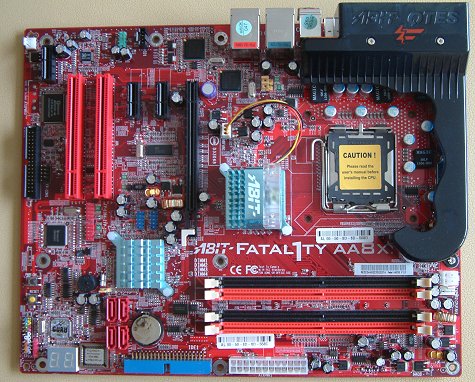
I recently took a look at ABIT's AX8 budget motherboard and found it to be a decent mainboard on all fronts. The Fatal1ty AA8XE, though, is based upon Intel's premium i925XE chipset, so ABIT has decided to load it with a slew of innovative features. The first departure from the AX8 and other budget boards is in the choice of PCB colour. The AA8XE simply looks meaner with a dark red PCB. Your eye, however, is immediately drawn towards the OTES appendage on the upper right-hand side.
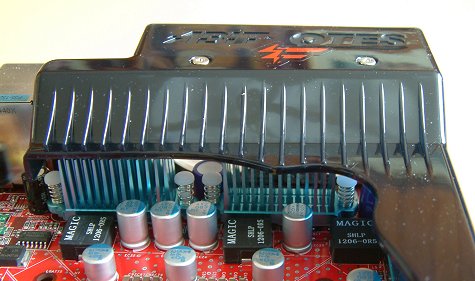
OTES cooling, on a motherboard, is primarily concerned with keeping the power-delivery system as cool as possible. That's why ABIT has covered the warm-running MOSFETs with heatsinks and placed a couple of 40mm fans right behind, to exhaust the inevitable build-up of heat. What's more, the fans have cool-looking red LEDs inside as an extra touch. In keeping with the devilish red theme, ABIT adorns the rest of the board with a number of red LEDs, too.
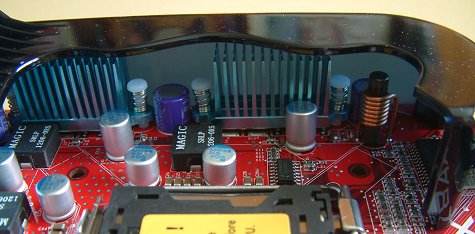
Looking at it with the board turned 90 degrees, it's an identical setup, save for a lack of fans. As you may already know, the i925XE chipset supports LGA775 processors that have contact pads on the bottom of the CPU. The regular pins are placed in the motherboard socket. That's why all responsible LGA775 board manufacturers pre-install a blanking cover that needs to be removed before the CPU/cooler can be mounted. The OTES system is secured on to the motherboard via extra-long screws that can be further tightened into regular motherboard mounts. ABIT has also added what it terms as OC Strips on the bottom of the PCB. These copper strips, ABIT claims, help remove some of the build-up of heat around the CPU/OTES area. Every little helps.
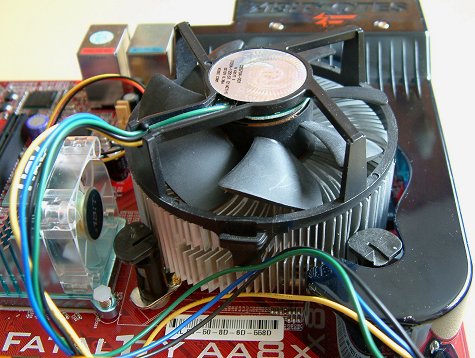
ABIT's designed the OTES cooling system with the reference heatsink in mind. It's a close, close fit, and installing the cooler is tricker than on open motherboards. The design also stops the use of larger aftermarket coolers, which is a real shame. Note that ABIT has also included a northbridge fan. However, on this occasion, the fan is pushing air across the heatsink rather than blowing from up top. The heatsink's a larger-than-normal affair, so the Fatal1ty has been designed with the enthusiast/overclocker as the ideal user.

Yet more cooling. The Fatal1ty AA8XE box contains a clip-on RAM cooler that's simplicity itself. The spring-loaded plastic sides attach on to the DIMM slots' locks, and a couple of 40mm fans blow warm-ish down on to the modules underneath. My only reservation with the apparatus is the length of the cable attached to the RAMFlow. Due to the OTES design and the CPU cooler using the only fan header on the right-hand side of the board, the RAMFlow's cable needs to extend to the header by the floppy port, on the far left-hand side. It's barely long enough. On a better note, the cooling appendage forces ABIT to locate the main 24-pin and 4-pin power connectors near the RAM, out of airflow's way.
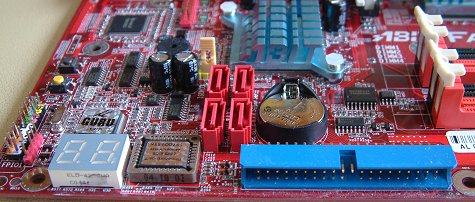
Common to most i925XE boards and Intel's preference for on-chip SATA, the Fatal1ty AA8XE has a single PATA port, rotated like on most of ABIT's recent Intel-based boards. ABIT's handy debug LED display is positioned next to the µGuru chip, which controls an impressive array of Windows-based tweaking/reporting options, including on-the-fly overclocking, hardware monitoring, and one-click BIOS updating (all too often the connection to the updating site fails and/or a BIOS is not present). 4 red-coloured SATA ports are all driven from Intel's ICH6/R Southbridge, which offers RAID0, 1, 0+1 support through Matrix Storage technology. Quite surprising considering this is ABIT's premium i925XE board that's priced at around £150, there's no additional discrete SATA, but ABIT will undoubtedly counter this criticism by pointing out the board is designed for the overclocking firmly in mind; I'm not so sure that it doesn't deserve a place here. Onboard power and reset buttons are also a nice touch, as are colour-coded motherboard-to-case pins. One can also use ABIT's external µGuru clock with this model. It displays various system characteristics on an easy-to-read display.
Peripheral connectivity sees 2 PCI and 2 PCI-Express X1 slots which are coloured red and black, respectively. Sound is routed through Intel's High-Definition Audio, via Realtek's trusty ALC880 8-channel CODEC, and then out to a special, supplied add-in audio card that fits into the PCI-Express-like black slot to the right of the 2 PCI's. A card is needed due to the OTES cooling taking up a large proportion of the I/O section, as seen below.

Two RJ45 ports denotes dual LAN status. One's run off an Intel 82541 Gigabit PCI-based controller. The other, for some unknown reason, is Intel's 82562 10/100 controller. Dual Gigabit Ethernet should be a given on this kind of board. 4 USB2.0 and a single FireWire400 port, powered by Texas Instruments controller, are all that fit once the OTES cooling system has been taken into account. That leaves no space for legacy ports. That's either a good or bad thing, depending upon exactly which peripherals you use.
The Fatal1ty AA8XE is a complex board that's actually laid out quite well. Priority has been giving to cooling over all-out features, evidenced by the lack of WiFi and discrete SATA support often seen on competitors' high-end i925XE boards. I'd recommend ABIT include a couple of extra fan headers, preferably close to the CPU, though.









